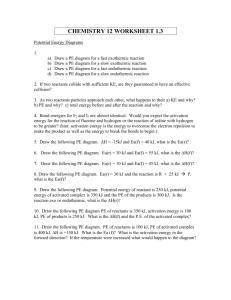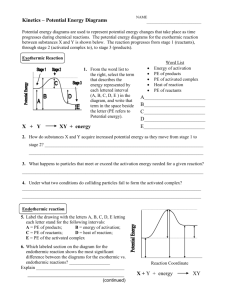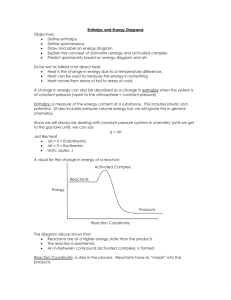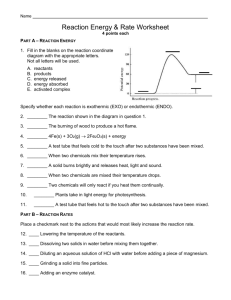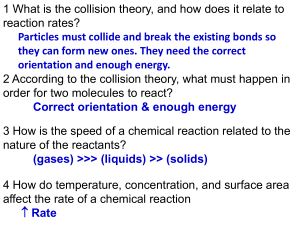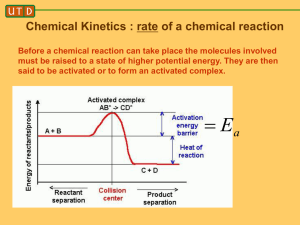PE Diagrams
advertisement
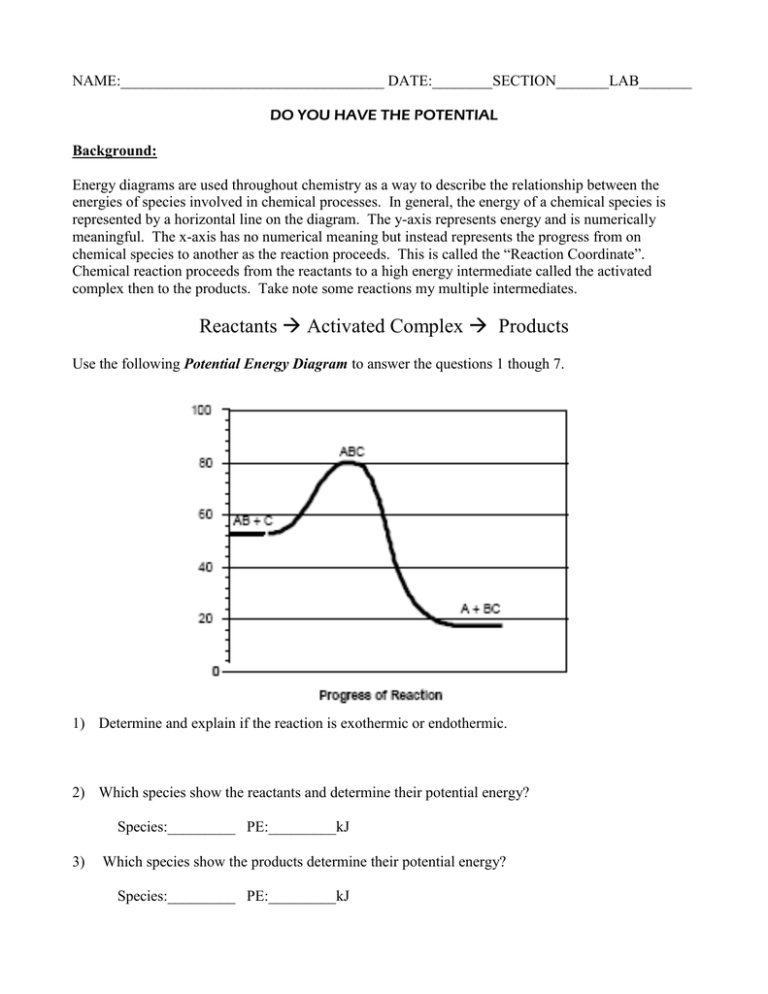
NAME:___________________________________ DATE:________SECTION_______LAB_______ DO YOU HAVE THE POTENTIAL Background: Energy diagrams are used throughout chemistry as a way to describe the relationship between the energies of species involved in chemical processes. In general, the energy of a chemical species is represented by a horizontal line on the diagram. The y-axis represents energy and is numerically meaningful. The x-axis has no numerical meaning but instead represents the progress from on chemical species to another as the reaction proceeds. This is called the “Reaction Coordinate”. Chemical reaction proceeds from the reactants to a high energy intermediate called the activated complex then to the products. Take note some reactions my multiple intermediates. Reactants Activated Complex Products Use the following Potential Energy Diagram to answer the questions 1 though 7. 1) Determine and explain if the reaction is exothermic or endothermic. 2) Which species show the reactants and determine their potential energy? Species:_________ PE:_________kJ 3) Which species show the products determine their potential energy? Species:_________ PE:_________kJ 4) Which species show the activated complex and determine its potential energy? Species:_________ PE:_________kJ 5) Determine the activation energy for the forward reaction. __________kJ 6) Determine the heat of reaction. ___________kJ 7) Determine the activation energy for the reverse reaction. _________kJ Use the following Potential Energy Diagram to answer the questions 8 though 21. 8) Determine if the reaction is exothermic or endothermic. Give one reason in terms of the diagram. Give one reason based on the balanced equation. Diagram: Equation: 9) Place the chemical formulas representing the reactants in their proper position on the diagram. 10) Place the chemical formulas representing the products in their proper position on the diagram. 11) On the diagram above circle the activated complex. 12) Draw a line 6 on the above diagram to represent the potential energy of the activated complex. 13) Which lines could be added together to show the potential energy of the activated complex? Line:______+ Line:________ 14) Describe what line 1 represents. 15) Describe what line 2 represents. 16) Describe what line 5 represents. 17) Which line shows the activation energy for the forward reaction? Line:___________ 18) On the above diagram draw the potential energy diagram with the addition of a catalyst. In your own words describe how the diagram has changed. 19) Which 2 lines can be subtracted to obtain ΔH, the heat of reaction. Line:____−Line:_____ 20) How much energy is required for this reaction if 4 mols of NO2 (g) are produced? 21) Describe the reaction’s change in entropy. Explain. For the following diagram interpret the meaning of the numbered lines and write at least 8 questions below based on the diagram. 22) Determine the enthalpy of the reactants. _____kJ 23) Determine the enthalpy of the products. ______kJ 24) Determine the enthalpy of the activated complex. _____kJ 25) Determine the activation energy of the forward reaction. _______kJ 26) Describe if the reaction is endothermic or exothermic. 27) Determine the heat of reaction (ΔH). ________kJ 28) Determine the activation energy of the reverse reaction. _______kJ 29) On the above diagram draw a curve showing the activation energy of a catalyzed reaction. 30) On the blank PE Diagram below draw the following: a) b) c) d) e) Label each axis and create a scale. PE of Reactants = 350 kJ PE of Products = 175 kJ Activation Energy = 100 kJ Catalyzed Activation Energy = 45 kJ (in a different color or dashed line) Reflection: Describe a potential energy diagram. Include the terms activation energy, heat of reaction, exothermic and endothermic.
